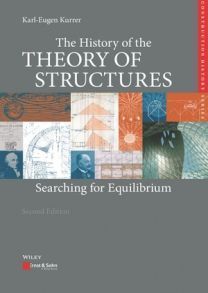Rezension von Ass. Prof. Dr. Dirk van de Vijver (Utrecht University), in: Bulletin van de Kon. Ned. Oudheidkundige Bond (KNOB), No. 3 (2023), S. 46-47
„(Das Buch) ist ein Muss für Bibliotheken von Ingenieur- und Architekturfakultäten sowie von kunst- und architekturhistorischen Studiengängen (...). Es ist vorbildlich für die Untersuchung technischer und mechanischer Aspekte innerhalb einer Disziplin, die - wie die Architekturgeschichte - zunehmend aus soziokultureller Perspektive betrieben wird. Kurrer Buch verdeutlicht die Tiefe einer solchen Forschung und die Relevanz für die Rekonstruktion bautechnikhistorischer Analysen.“
Ed Buch im Newsletter der „Los Angeles Chapter of the Construction Specifications Institute“ (Aug. 24, 2019)
„In addition to the book, 'The History of the Theory of Structures, From Arch Analysis to Computational Mechanics' by Karl-Eugen Kurrer, that is the basis for most of this article, I also used the book, 'Engineering in History' by Kirby, Withington, Darling, & Kilgour, (published by McGraw Hill in 1956, with 530 pages), for information on ancient construction. There is a new and enlarged edition of 'The History of the Theory of Structures. Searching for Equilibrium', although as you can see it has a slightly revised title. It was published in 2018 by Ernst & Sohn, Berlin, and has 1,212 pages. Both editions trace in great and interesting detail the history of structures and structural design from their beginnings in Galileo’s time up to the computational statics used today. Biographies of important engineers are presented along with a history of engineering education in Europe and the USA. The book is enhanced by many photographs, historical drawings, and diagrams.“
Prof. Dr.-Ing. Hans-Wolf Reinhardt in „Magazine of Concrete Research“ (Volume 70 Issue 20, October, 2018, S. 1080–1080) / RILEM News (International Union of Laboratories and Experts in Construction Materials, Systems and Structures)
„K.-E. Kurrer’s book is a compreshensive treatise on the theories that are used for analysis and design of structures from the earliest days (Archimedes’ lever principle) to the present (finite element method). Those who have read the first edition of the book will be surprised by the huge amount of history and knowledge which has been added in the second edition. One can still read the individual chapters in isolation without loosing the broad view on the total. The book is well illustrated with pictures, graphs, historical drawings and sketches, which makes for entertaining reading. It contains a wealth of information and is therefore a source for historians, especially interested in the history of technology, but also for professional engineers and graduate students of engineering and art history. The book is a necessary element of libraries and engineering departments.“
Prof. Guo-qiang Li and Chang Ji, Tongji University, Shanghai, China, in „Engineering Mechanics“, 11/2019, p. 13:
"In this book, the development of the theory of structures is introduced from a historic-logical perspective. It demonstrates the complicated relationship of the theory of mechanics and structural engineering spanning from the ancient Greece to modern computer age in a roughly chronological order, which could be called the encyclopedia of the development of the theory of structures."
Dr. Bill Addis (London-Teddington, United Kingdom) in „Engineering History and Heritage“ (Vol. 173, 2020, Issue 2, p. 75)
„No historical work can be comprehensive, but Kurrer has surely come as close as anyone can.“
Dr. Bill Addis (London-Teddington, United Kingdom) in „Steel Construction - Design and Research“, (Vol. 12, 2019, Issue 3, p. 259)
„Kurrer's achievement in compiling this book is colossal, and I commend it to everyone interested in the subject“
Dr. Bill Addis (London-Teddington, United Kingdom) in „The Structural Engineer“ (Vol. 97, 2019, Issue 8, S. 34:)
„This edition is the most comprehensive book on the subject in any language.“
Dr. David J. Gunaratnam (University of Sydney, Faculty of Architecture Design) in„Architectural Science Review - Newlsletter“, 2018, Vol. 4, No. 3, p. 3:
„(...) the book provides a detailed and comprehensive study of the behavioural models, along withe the theories and methods, for compression and flexural structural members, types and systems (....).“
Em. o. Univ.Prof. Dipl.-Ing. Dr. techn. Dr. h.c. mult Herbert A. Mang, Ph.D. in „Österreichische Ingenieur- und Architekten-Zeitschrift (ÖIAZ)“ (163. Jg., No. 1-12, 2018, S. 260)
„Möge dem Buch in zweierlei Hinsicht großer Erfolg beschieden sein, und zwar erstens als zur Reflexion über eigene Erfahrungen mit der Wissenschaftsdisziplin Baustatik anregendes Werk und zweitens als unentbehrlicher Lehrbehelf für Vorlesungen über die Geschichte der Baustatik an Technischen Universitäten und Fachhochschulen.“
Dr. Bill Addis in „Construction History“, (Vol. 34, No. 1, 2019, S. 133-134)
„This substantial volume is a greatly-expanded (by 50%) second edition of the first edition published in 2008. It is the most comprehensive book on the subject in any language. (...). Kurrer's achievement in compiling this book is colossal, and I commend it to everyone interested in the subject. It will, for a long time, stand well along side the other classics of the field - Timoshenko's 'History of Strength of Materials" and Edoardo Benvenuto's 'Introduction to the History of Structural Mechanics'.“
Prof. Dr. hab. inz. Zbigniew Cywiński in „Inzynieria Morska i Geotechnika“ 4/2018 S. 313
Der Rezensent empfiehlt vorliegendes Buch wärmstens - auch den Lesern in Polen. Bauingenieure, Architekten und Umweltingenieure, sowie Studierende der genannten Disziplinen finden dort zahlreiche Anregungen zum Nachdenken.
Dipl.-Ing. Eberhard Pelke in „Stahlbau“ (10/2018, S. 1025–1026)
„Karl-Eugen Kurrer (...) führt uns Bauingenieure durch die Jahrhunderte und zeigt uns, welch schönen Beruf wir haben. Deshalb sei das Buch auch all jenen ans Herz gelegt, die Tablet und Smartphone im Urlaub zur Seite legen können, lieber in die Welt der Bücher eintauchen und ihre Verortung als Ingenieur erforschen möchten.“
Prof. Ing. Ivan Baláž, PhD., in „Zváranie Svarováni“ (3/2018, S. 37)
„This great publication presents a work focused on development of theory of structures in the period of the last 500 years. It is not only very interesting reading but also the source of very valuable informations also for active designers. Publication may be recommended to the scientific researchers, lecturers and students at univerzities and to engineers in the practice as well.“
Prof. dr hab. inz. Zbigniew Cywiński in „Inzynieria i Budownictwo“ (12/2018, S. III)
„Das Buch ist ein hervorragendes Werk und verdient das Interesse der Fachleute. (...) Die hohe Qualität des Buches resultiert aus der tiefen Bindung der technikwissenschaftlichen Grundlagendisziplinen mit den humanistischen Erfordernissen der heutigen Zeit.“
Prof. Dr. Andreas Kahlow (Berlin), in „Mauerwerk“ (1/2019, S. 68–69)
„Das insgesamt (...) 1212 Seiten starke Werk ist in (...) 15 Kapitel unterteilt. Rechnerische Exkurse helfen beim Verständnis des schwierigen Stoffes. Vor allem die letzten drei Kapitel belegen in besonderer Weise das Anliegen von Karl-Eugen Kurrer, die Geschichte der Baustatik auch sozialgeschichtlich zu hinterfragen (...). Die ,History of the Theory of Structures‘ von Karl-Eugen Kurrer ist damit weit mehr als nur ein Fachbuch. Die Frage des Woher und Wohin der Entwicklung technischer Wissenschaften ist mit Motiven und Handlungen der Protagonisten der Theorieentwicklung eng verknüpft.“
Prof. dr hab. inz. Zbigniew Cywiński in „Archives of Civil Engineering“ (2/2018, S. 201–203)
„K.-E. Kurrer has mastered a meaningful monograph in world scale – on the beginnings, development, and state-of-the-art of the civil and structural engineer’s technical knowledge; even more – the new version, uncommonly, activates his philosophical feelings, referring also to the humanistic background of technology. (…) Once more, it must be stated that the examined book has all virtues of an outstanding, excellent work.“
Prof. Dr. Marcilio Alves in „Latin American Journal of Solids and Structures“ (2019, 16[3], e167)
„History puts knowledge in perspective (…). This could not be more true when one is faced with the monumental work of Karl-Eugen Kurrer, The History of the Theory of Structures: Searching for Equilibrium (…). I would highly recommend this book for all those interested in give meaning to what was said in the opening of this text: history puts knowledge in perspective.“
Em. o. Univ.Prof. Dipl.-Ing. Dr. techn. Dr. h.c. mult Herbert A. Mang, Ph.D. in „Computer Assisted Methods in Engineering Science (CAMES)“ (Vol. 25, No. 3-4, 2018, pp. 122)
„May this book be successful on two counts: firstly, as a work that encourages us to reflect on our own experiences with the scientific discipline of structural analysis and, secondly, as an indispensable aid for lectures on the history of the theory of structures at universities and polytechnics.“
Dr.-Ing. Roland May in „architectura“ (Band 46/2016 [2019], S. 291–293)
„(...) Kurrers teils sehr subjektive Blicke auf die faszinierend vielgestaltige Geschichte der Baustatik der
letzten Jahrhunderte (bereiten) (...) ein bei diesem Thema unerwartetes Lesevergnügen, das von der
üppigen Illustration mit über 1000 Abbildungen noch unterstützt wird. (...)
Das Buch ist (...) gerade auch für Architekturhistoriker und Bauforscher von größtem Interesse.“ (S. 293)
Dr.-Ing. Roland May, Lehrstuhl für Bautechnikgeschichte der BTU Cottbus-Senftenberg
Das könnte Sie auch interessieren
- de Borst, René / Crisfield, Mike A. / Remmers, Joris J. C. / Verhoosel, Clemens V.
Nichtlineare Finite-Elemente-Analyse von Festkörpern und Strukturen
Oktober 2014- 587 Seiten
- Softcover
- Deutsch
ISBN: 978-3-527-33660-9Gedruckte Ausgabe derzeit nicht lieferbar - mehr






